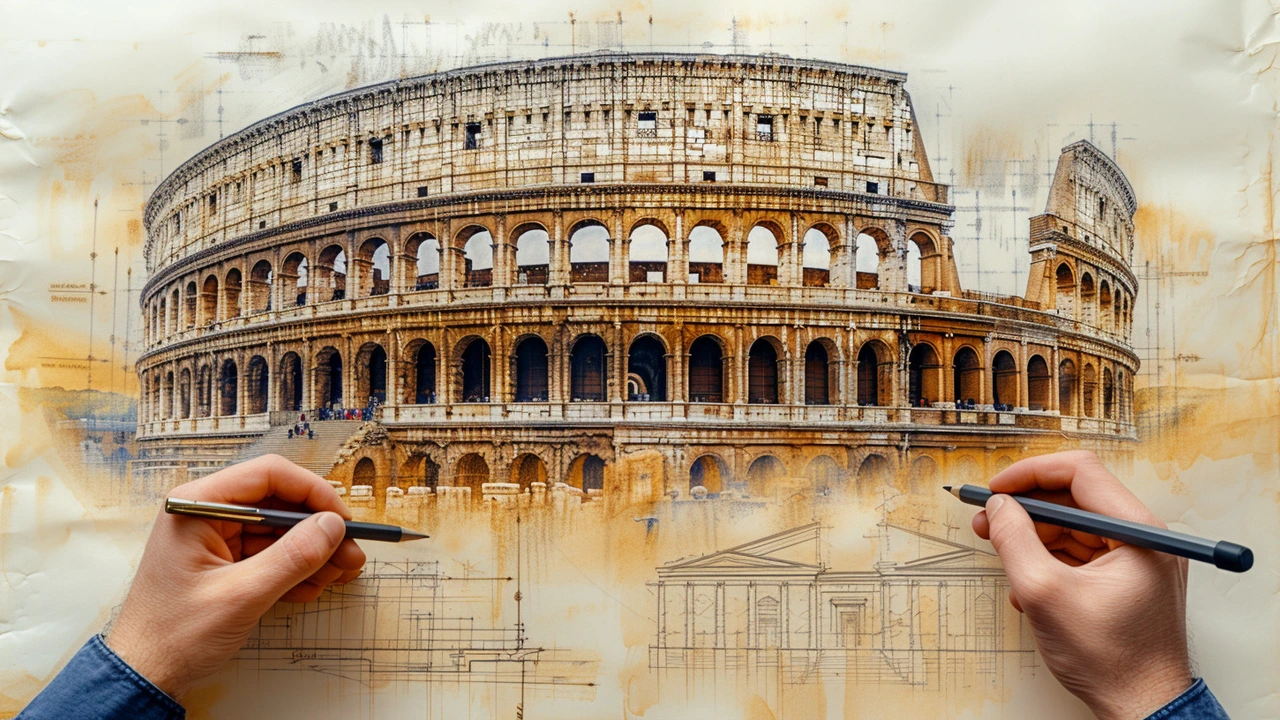The Evolution of Ancient Roman Architecture
 Oct, 24 2023
Oct, 24 2023
The Foundations of Roman Architecture
I find it pretty amusing how, when I play fetch with Beau, my adorable Poodle, he always, without fail, tries to fit three toys in his mouth at once. It reminds me of the Roman Empire, trying to incorporate myriad cultures into one, which reflected in their architecture. Roman architecture began by observing and absorbing the concepts practiced by the Greeks and Etruscans. The Romans, acting like resourceful architects, adapted and shifted these architectural norms to serve their unique needs and aesthetic tastes. Just like Beau, trying to fit in all his toys, Rome had its way of blending different architectural styles into a harmonious whole.
Material Matters
Imagine if Liara, my Siamese cat, had turned her nose up at the salmon-based kitty kibble and demanded an exotic delicacy from, say, Madagascar. That's a bit what it was like when the Romans decided that Greek marble was just the ticket! They significantly moved away from mundane materials like mudbrick and timber, used by their predecessors, and instead embraced robust or high-end materials. To counter this variation in resource availability, Roman architects became ingenious innovators. They began using travertine, a type of limestone, and eventually perfected the art of making concrete. They also imported marble, obtaining it from far-reaching corners of the Roman empire. Unsurprisingly, all these substitutions added to the grandeur and longevity of Roman architecture.
The Ingenious Innovation of Concrete
When my husband, Damian, refused to shell out for a store-bought bookshelf and decided he would DIY one instead, he maybe bit off more than he could chew. Similarly, when the Romans decided to introduce concrete (or caementa as they called it) into their architecture, it wasn't a smooth transition. However, just as Damian finally mastered the art of assembling a bookshelf, the Romans got the hang of concrete. By incorporating ash into the mix, they created an impressively resilient concrete, nearly waterproof and capable of setting underwater. It's like how Damian's bookshelf evolved from a rickety, wobbly thing, to a sturdy structure serving its purpose splendidly.
Aqueducts: The Lifeblood of Roman Society
Think about the days when the Wi-Fi signal nosedives and the connection becomes as erratic as Beau when he sees a squirrel. Aqueducts, in the Roman society, were a little like our Wi-Fi - crucial for the smooth functioning of the society. The concept of aqueducts, as a system for water delivery, demonstrates remarkable engineering intellect. With a clever use of gravity for water transportation, Romans ensured a sustainable supply of water to their cities, farms, and even individual households. As far as sustainable designs go, Romans were clearly ahead of their times.
Roads: Paving the Way to Rome
Road network in the Roman empire puts our current highway system (and definitely our sidewalk repairs) to shame. The Roman road system was so comprehensive and well-maintained that it infused a sense of connectivity within the empire, sanitizing the famous saying, "All roads lead to Rome." These roads, well-planned and often layered with gravel, concrete, and paving stones, facilitated easy and fast travel. So, the next time you find yourself stuck in traffic, remember, it was the Romans who set the precedent for efficient commuting!
Arches, Vaults, and Domes
My cat, Liara, has a coveted spot atop a circular cat tower placed near the apartment windows. The top of this tower is domed for her comfort, making it a perfect perch for bird-watching or glaring at Beau. It's similar to how architectural elements like arches, vaults, and domes became symbolic of Roman construction. These structures formed the crux of iconic Roman edifices, like the Pantheon and the Colosseum, primarily for their strength and space-creating abilities, similar to the cat tower that creates more scope for Liara to leap.
Splendid Sculptures: Roman Statues and Bas Reliefs
Have you ever found yourself in the pet aisle of a supermarket, befuddled by the array of toys, just like Damian and I do? Selecting pet toys can be just as intricate as Roman bas relief artforms! The Romans, taking a leaf from the Greek's love for sculpture, added a dash of practicality. They employed statues and bas relief not merely as decorative art but also to convey narratives. The Romans practically invented the comic strip!
Amphitheatres and Theatres: Spectacles of Entertainment
Being trapped in a house with Beau and Liara is quite similar to being in a Roman amphitheater. There's plenty of drama, athletic feats of agility, and continuous entertainment. Roman theatres and amphitheaters, like the Colosseum, were integral to the social fabric. They hosted gladiatorial contests, with thousands partaking in the collective euphoria, akin to how I feel when Liara and Beau do something particularly amusing.
I hope this atmospheric travel through the majestic world of Roman architecture kept you interested. Take it from me, a modern-day Juliette exploring ancient wonders, that there's so much more to Roman architecture than you think. And who knows, you might find some ancient inspiration the next time you play fetch with your Poodle or watch your Siamese cat climb her tower!